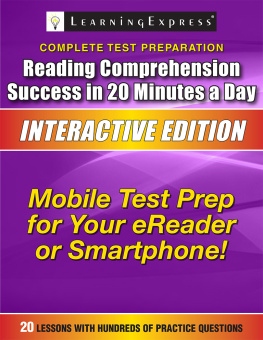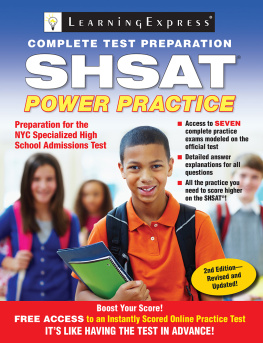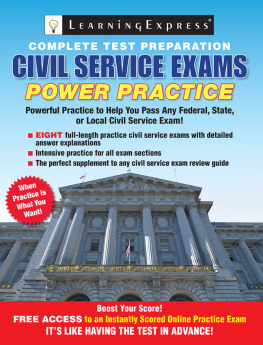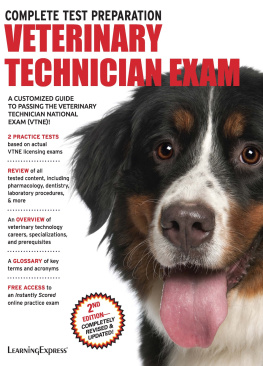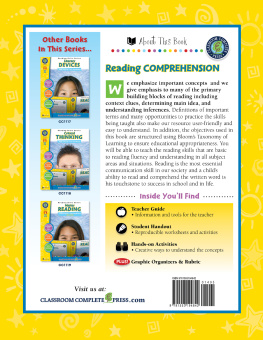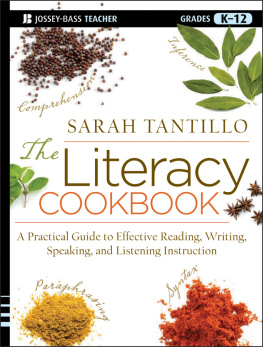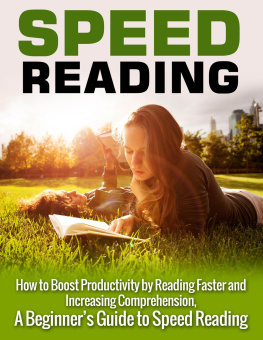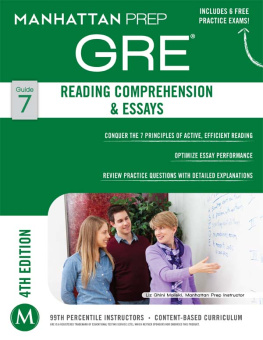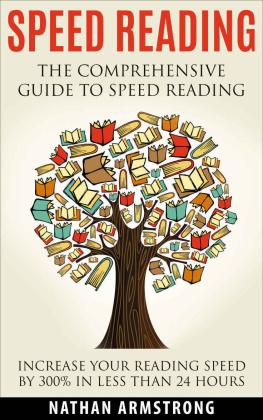How to Use This Book
his book is designed to help you improve your reading comprehension skills by studying 20 minutes a day for 20 days. Youll start with the basics and move on to more complex reading comprehension and critical thinking strategies. Please note that although each chapter can be an effective skill builder on its own, it is important that you proceed through this book in order, from Lesson 1 through Lesson 20. Each lesson builds on skills and ideas discussed in the previous chapters. As you move through this book and your reading skills develop, the passages you read will increase both in length and in complexity.
The book begins with a pretest, which will allow you to see how well you can answer various kinds of reading comprehension questions now, as you begin. When you finish the book, take the posttest to see how much youve improved.
The text is divided into four sections, each focusing on a different group of related reading and thinking strategies. These strategies will be outlined at the beginning of each section and then reviewed in a special putting it all together final lesson.
Each lesson provides several exercises that allow you to practice the skills you learn. To ensure youre on the right track, each lesson also provides answers and explanations for all of the practice questions. Additionally, you will find practical suggestions in each chapter for how to continue practicing these skills in your daily life.
The most important thing you can do to improve your reading skills is to become an active reader. The following guidelines and suggestions will familiarize you with active reading techniques. Use these techniques as much as possible as you work your way through the lessons in this book.
Becoming an Active Reader
Critical reading and thinking skills require active reading. Being an active reader means you have to engage with the text, both mentally and physically.
The following are active reading strategies:
- Skim ahead and jump back.
- Mark up the text.
- Make specific observations about the text.
Skimming Ahead and Jumping Back
Skimming ahead enables you to see whats coming up in your reading. Page through the text youre about to read. Notice how the text is broken down, what the main topics are, and the order in which they are covered. Notice key words and ideas that are boldfaced, bulleted, boxed, or otherwise highlighted. Skimming through the text beforehand will prepare you for what you are about to read. Its a lot like checking out the hills and curves in the course before a cross-country race. If you know whats ahead, you know how to pace yourself, so youre prepared to handle whats to come.
When you finish your reading, jump back. Review the summaries, headings, and highlighted information in the text. Notice both what the author highlighted and what you highlighted. By jumping back, you help solidify in your mind the ideas and information you just read. Youre reminded of how each idea fits into the whole, how ideas and information are connected. When you make connections between ideas, youre much more likely to remember them.
Marking Up the Text
Marking up the text creates a direct physical link between you and the words youre reading. It forces you to pay closer attention to the words you read and takes you to a higher level of comprehension. Use these three strategies to mark up text:
- Highlight or underline key words and ideas.
- Circle and define any unfamiliar words or phrases.
- Record your reactions and questions in the margins.
Highlighting or Underlining Key Ideas
When you highlight or underline key words and ideas, you are identifying the most important parts of the text. Theres an important skill at work here: You cant highlight or underline everything, so you have to distinguish between the facts and ideas that are most important (major ideas) and those facts and ideas that are helpful but not so important (minor or supporting ideas). Highlight only the major ideas, so you dont end up with a text thats completely highlighted.
An effectively highlighted text will make for an easy and fruitful review. When you jump back, youll be quickly reminded of the ideas that are most important to remember. Highlighting or underlining major points as you read also allows you to retain more information from the text.
Circling Unfamiliar Words
One of the most important habits to develop is that of circling and looking up unfamiliar words and phrases. If possible, dont sit down to read without a dictionary by your side. It is not uncommon for the meaning of an entire sentence to hinge on the meaning of a single word or phrase, and if you dont know what that word or phrase means, you wont understand the sentence. Besides, this habit enables you to quickly and steadily expand your vocabulary, so youll be a more confident reader and speaker.
If you dont have a dictionary readily available, try to determine the meaning of the word as best you can from its contextthat is, the words and ideas around it. (Theres more on this topic in Lesson 3.) Then, make sure you look up the word as soon as possible so youre sure of its meaning.
Making Notes in the Margins
Recording your questions and reactions in the margins turns you from a passive receiver of information into an active participant in a dialogue. (If youre reading a library book, write your reactions in a notebook.) You will get much more out of the ideas and information you read about if you create a conversation with the writer. Here are some examples of the kinds of reactions you might write down in the margin or in your notebook:

